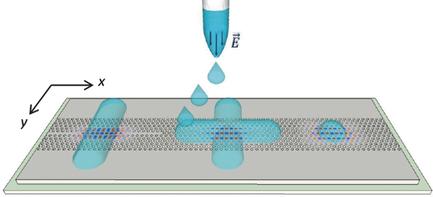当前位置:
X-MOL 学术
›
Adv. Mater.
›
论文详情
Our official English website, www.x-mol.net, welcomes your
feedback! (Note: you will need to create a separate account there.)
Inkjet‐Printed Nanocavities on a Photonic Crystal Template
Advanced Materials ( IF 27.4 ) Pub Date : 2017-10-24 , DOI: 10.1002/adma.201704425 Frederic S. F. Brossard 1 , Vincenzo Pecunia 2, 3 , Andrew J. Ramsay 1 , Jonathan P. Griffiths 2 , Maxime Hugues 4, 5 , Henning Sirringhaus 2
Advanced Materials ( IF 27.4 ) Pub Date : 2017-10-24 , DOI: 10.1002/adma.201704425 Frederic S. F. Brossard 1 , Vincenzo Pecunia 2, 3 , Andrew J. Ramsay 1 , Jonathan P. Griffiths 2 , Maxime Hugues 4, 5 , Henning Sirringhaus 2
Affiliation

|
The last decade has witnessed the rapid development of inkjet printing as an attractive bottom‐up microfabrication technology due to its simplicity and potentially low cost. The wealth of printable materials has been key to its widespread adoption in organic optoelectronics and biotechnology. However, its implementation in nanophotonics has so far been limited by the coarse resolution of conventional inkjet‐printing methods. In addition, the low refractive index of organic materials prevents the use of “soft‐photonics” in applications where strong light confinement is required. This study introduces a hybrid approach for creating and fine tuning high‐Q nanocavities, involving the local deposition of an organic ink on the surface of an inorganic 2D photonic crystal template using a commercially available high‐resolution inkjet printer. The controllability of this approach is demonstrated by tuning the resonance of the printed nanocavities by the number of printer passes and by the fabrication of photonic crystal molecules with controllable splitting. The versatility of this method is evidenced by the realization of nanocavities obtained by surface deposition on a blank photonic crystal. A new method for a free‐form, high‐density, material‐independent, and high‐throughput fabrication technique is thus established with a manifold of opportunities in photonic applications.
中文翻译:

光子晶体模板上的喷墨打印纳米腔
过去十年见证了喷墨打印技术的快速发展,因为它具有简单性和潜在的低成本优势,是自下而上的一种有吸引力的微细加工技术。大量可印刷材料一直是其在有机光电子和生物技术中广泛采用的关键。但是,迄今为止,它在纳米光子学中的实现受到常规喷墨打印方法的较粗糙分辨率的限制。此外,有机材料的低折射率会阻止在需要强光限制的应用中使用“软光子学”。本研究介绍了一种用于创建和微调高Q值的混合方法纳米腔,涉及使用市售的高分辨率喷墨打印机将有机墨水局部沉积在无机2D光子晶体模板的表面上。该方法的可控制性通过通过印刷机通过的次数调整印刷的纳米腔的共振以及通过制造具有可控分裂的光子晶体分子来证明。通过在空白光子晶体上进行表面沉积获得的纳米腔体的实现,证明了该方法的多功能性。因此,建立了一种自由形式,高密度,材料独立和高通量制造技术的新方法,并为光子应用带来了许多机遇。
更新日期:2017-10-24
中文翻译:

光子晶体模板上的喷墨打印纳米腔
过去十年见证了喷墨打印技术的快速发展,因为它具有简单性和潜在的低成本优势,是自下而上的一种有吸引力的微细加工技术。大量可印刷材料一直是其在有机光电子和生物技术中广泛采用的关键。但是,迄今为止,它在纳米光子学中的实现受到常规喷墨打印方法的较粗糙分辨率的限制。此外,有机材料的低折射率会阻止在需要强光限制的应用中使用“软光子学”。本研究介绍了一种用于创建和微调高Q值的混合方法纳米腔,涉及使用市售的高分辨率喷墨打印机将有机墨水局部沉积在无机2D光子晶体模板的表面上。该方法的可控制性通过通过印刷机通过的次数调整印刷的纳米腔的共振以及通过制造具有可控分裂的光子晶体分子来证明。通过在空白光子晶体上进行表面沉积获得的纳米腔体的实现,证明了该方法的多功能性。因此,建立了一种自由形式,高密度,材料独立和高通量制造技术的新方法,并为光子应用带来了许多机遇。











































 京公网安备 11010802027423号
京公网安备 11010802027423号